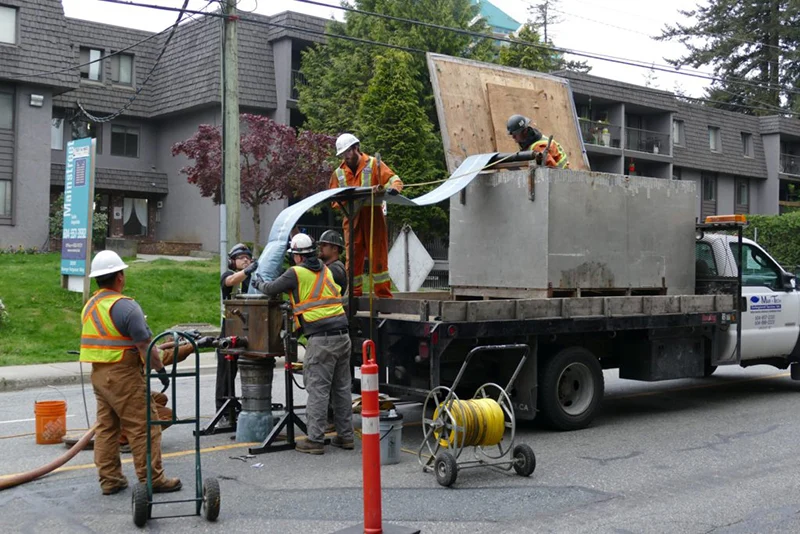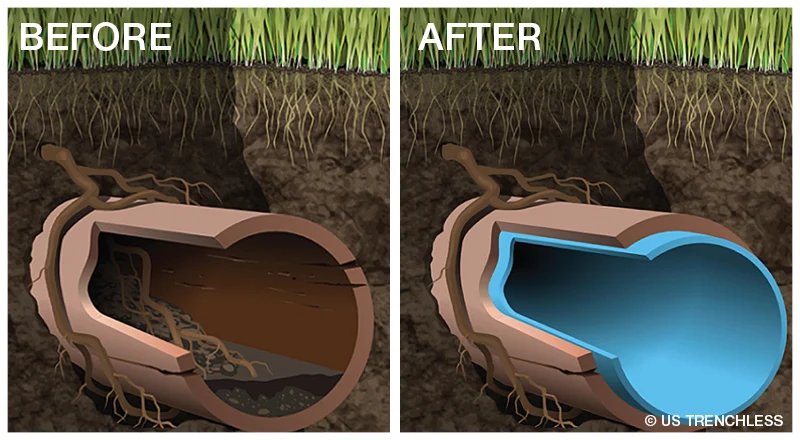
Michelle Dodroe, P.E., MBA
Vice President - InfrastructureThere exists an increasing need for infrastructure rehabilitation. Factors in this struggle include rising community expectations, increasing environmental awareness, diminishing financial resources, aging infrastructure, growing risk management, and regulator expectations. To mitigate these issues, several trenchless rehabilitation methods have emerged from this growing need, including CIPP, Slip Lining, and Pipe Bursting. Design factors such as hydraulic capacity, line location, and other existing utilities determine which techniques are appropriate. CIPP can provide one of the most effective, comprehensive solutions to the rehabilitation of pipes with existing limitations.
Cured-In-Place Pipe, or CIPP, was introduced by Eric Wood and first used in London, England, in 1971. It is a full-segment rehabilitation of pipe and takes on the shape of the host pipe, essentially becoming a pipe within a pipe. This trenchless technology is used to remediate or repair subsurface utility pipes, most often sanitary sewer. In many cases, a community’s aging sewer infrastructure is leaking, collapsing, or has been compromised and is subject to exfiltration and/or infiltration.
Exfiltration happens when sewage in a pipe is allowed to improperly exit the system and enter the surrounding environment, which is prohibited by the Environmental Protection Agency (EPA). Infiltration happens when ground water is allowed to enter the system. This impacts the system’s design capacity and can lead to overflows and increased treatment expenses.
IPP consists of a non-woven fabric impregnated with resin, either pulled into place or inverted, inflated, and cured by heat (steam or heated water) or UV-light. There are typically two types of fabric used in CIPP, felt and fiberglass. Resins include polyester, vinyl ester, or epoxy and can be either factory applied and transported to the site in a lightless temperature-controlled manner, or wetted on site. Typically, resin is applied to the liner in the climate controlled factory, however, some circumstances, such as large pipe sizes, require an on-site or over-the-hole wet-out process due to transportation limitations.
Most resins used with CIPP are styrene-based. While curing CIPP, a noticeable styrene odor is present; however, levels released are not dangerous and are well within the National Institute of Occupational Safety and Health (NIOSH) recommendations. Keeping the local public appraised of this information is key to reducing public health concerns during CIPP projects. Additionally, UV-cured liners release less styrene odor and can be beneficial for this reason in areas of high sensitivity.
CIPP can be installed to restore the structural integrity of an entire pipe or as a spot repair to mitigate a localized point in need of repair.

© PW Trenchless - Image Source: pwtrenchless.com
CIPP is secured in place using a mechanical lock on the current host pipe at the manholes and pipe joints. The interface between the liner and the host pipe is sealed at the manholes to eliminate infiltration and exfiltration of the system. CIPP is best used in host pipe materials other than plastic, and can accommodate uncommon pipe shapes, such as egg shaped, and materials, including brick.
Because sewer by-pass of the system is necessary during installation, it is recommended to notify affected property owners of the planned temporary interruption of service. Typically, the contractor will leave door hangers in the project area to prepare residents and businesses, giving them a point of contact for questions.
The CIPP process begins with pre-cleaning to remove roots and debris from inside the pipe. Then the pipe is inspected using closed-circuit television (CCTV). This is called “Pre-CCTV” in the work contract. If the pipe is a good candidate for CIPP installation, the method, material, thickness, and tolerances are established.
Once installed, the resin must cool completely at a controlled rate to prevent snapping or delamination issues. Samples are collected and sent to a certified laboratory for flexural modulus and modulus of elasticity testing of the cured material. Typically, one (1) sample is sent for every 1,000 LF of CIPP installed on a job. Meanwhile, the service connections are reestablished.

Finally, “Post-CCTV’ data is collected and inspected for defects. The final acceptance of the line is based on materials testing results and post-CCTV documentation. Usually, the material supplier and the installation contractor will provide separate warranties for a standard period of time.
Pricing per linear foot naturally improves with higher quantities of installation.
Pros:
- Cost effective compared to trenching and site restoration.
- Minimally invasive. Can be accomplished with less service interruption, traffic disruption, and public inconvenience.
- Work is completed in much shorter time frames, usually within hours instead of weeks.
- CIPP is a structural reformation and extends the lifecycle of the pipe. Not merely patching but fully restoring pipe integrity.
- CIPP can reestablish a smoother interior surface for partially or fully degraded pipes to increase flow capacity. Additionally, this method of remediation minimally reduces the interior diameter of the host pipe.
Cons:
- CIPP does have limitations to the pipe failures it is applicable to. It cannot correct a sag in the pipe, pipe intrusions, severely offset joints, or larger holes that can allow the CIPP to balloon into a vacant space.
- Installation usually requires certified specialists.
- CIPP can be improperly installed. The lining can snap, delaminate, wrinkle, have dry spots, curing irregularities, or foreign inclusions.
CIPP installation specifications come from ASTM F1216-12 and F1743-13. Tube and resin material specifications are found in ASTM D5813-14. The National Association of Sewer Service Companies (NASSCO) has been proactively developing CIPP health and safety requirements for over 35 years, including an inspector training and certification program.